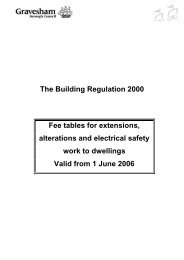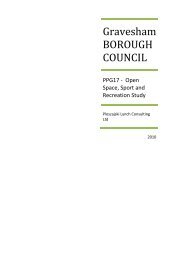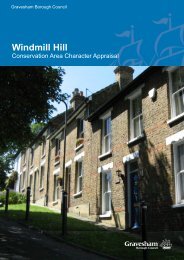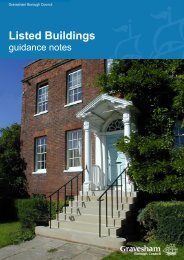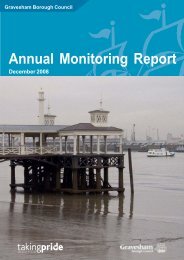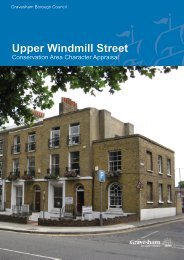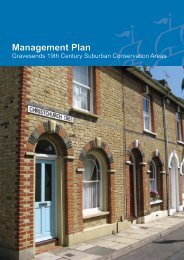gravesend riverside conservation area - Gravesham Borough Council
gravesend riverside conservation area - Gravesham Borough Council
gravesend riverside conservation area - Gravesham Borough Council
You also want an ePaper? Increase the reach of your titles
YUMPU automatically turns print PDFs into web optimized ePapers that Google loves.
Riverside Conservation Area Appraisal 2009<br />
30<br />
bustling centre that mixed commercial and<br />
residential uses, and the adjoining streets<br />
catered for the varying needs of residents.<br />
A Congregational chapel opened in Princes<br />
Street in 1717.<br />
In response to increased international tension<br />
at the end of the 18th century, the defences<br />
at Gravesend were strengthened with the<br />
construction of the New Town Fort to the east<br />
of Gravesend Blockhouse, and new taller<br />
stone walls were built, connecting the two<br />
fortifications. The fort remained in use and<br />
was substantially rebuilt in the 19th century by<br />
Gravesend resident General Charles Gordon,<br />
whose famous deeds in China and Africa<br />
epitomise the image of the heroic Victorian<br />
military commander. His connection with<br />
Gravesend reinforces the town’s link with the<br />
maritime military, and the <strong>riverside</strong> <strong>area</strong> even<br />
retains the Mission House in which Gordon<br />
once taught.<br />
The 19th century also saw the development<br />
of the town in other ways. Gravesend became<br />
a destination for day trippers from London<br />
and visitors would arrive by steam boat and<br />
would then walk up Windmill Hill to take in<br />
the views and enjoy the entertainment. In the<br />
1840s Rosherville Gardens were also opened.<br />
These pleasure grounds were created to the<br />
east of the town, ran up to the river’s edge<br />
and wound up the cliffside to give impressive<br />
views across the river to Tilbury. In its heyday<br />
20,000 visitors came to Gravesend every<br />
year, many of whom would have to pass from<br />
the newly built Town Pier through the Town<br />
Quay (now Town Pier Square). Engravings<br />
from the time show visitors on the promenade<br />
along the riverfront, and many would have<br />
continued to walk up High Street to Windmill<br />
Hill.<br />
By the end of the 19th century, fashions had<br />
changed and the improved railway network<br />
took day trippers to further afield resorts<br />
such as Margate and Ramsgate. Gravesend<br />
became more industrial as chalk pits and<br />
brickworks were opened in the surrounding<br />
<strong>area</strong>s, particularly Northfleet. Eventually<br />
Rosherville Gardens was closed and<br />
transformed into a cement works (utilising the<br />
local chalk). The marine industries, such as<br />
fishing and shrimping, which had supported<br />
the community in earlier centuries, came back<br />
to the fore, although modern advancements in<br />
shipbuilding meant that many ancillary trades<br />
were no longer required.<br />
The opening of the Tilbury docks in 1886<br />
provided some alternative means of<br />
employment. Travel to work was made<br />
possible by the ferry service between the two<br />
ports, which was converted to steam power in<br />
1855. The industrialisation of the north shore<br />
of the Thames continued into the 20th century<br />
and in the 1950s a large power station was<br />
constructed at Tilbury. This giant structure and<br />
its smoking towers has dominated the view<br />
out of Gravesend ever since.<br />
In the 20th century Gravesend continued<br />
to grow as a small market town with <strong>area</strong>s<br />
of light industry. Much of the industry was<br />
occupied with producing building materials<br />
which were often used to build houses in<br />
nearby London. As transport links to the city<br />
improved, Gravesend became a commuter<br />
settlement and with the addition of large<br />
retail parks close by, commercial trade has<br />
waned in the town. However, there has also<br />
been much development in the town, mostly<br />
residential. The majority of construction has<br />
been beyond the boundary of the Queen<br />
Street Conservation Area, although some<br />
historic buildings have been lost and replaced<br />
within the Conservation Area in the late<br />
20th century. The Town Pier closed in 1969




